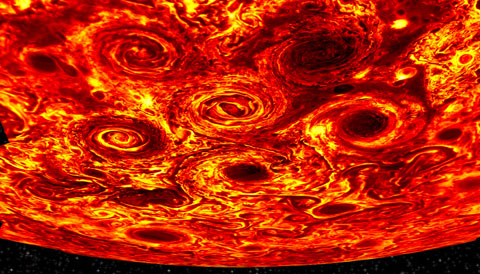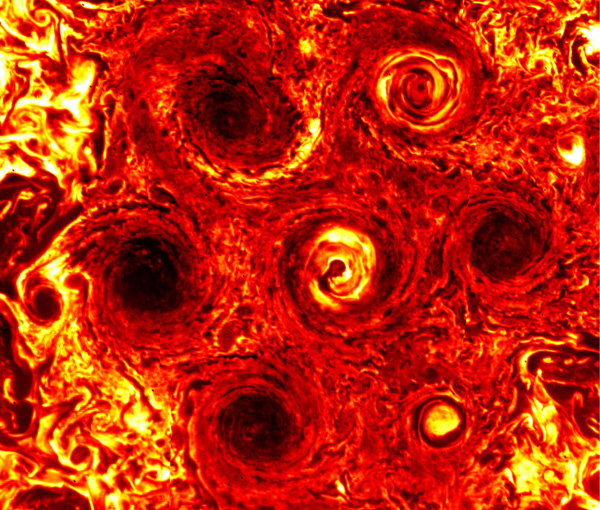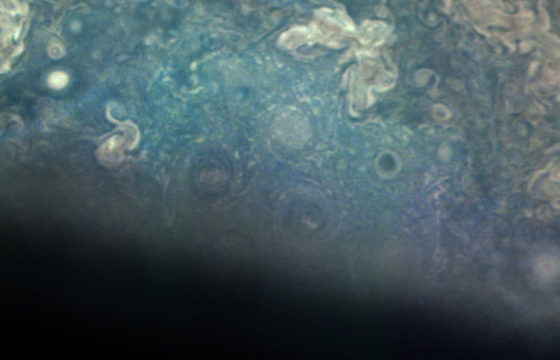Stunning new images from NASA’s Juno mission reveal that a new cyclone has budged its way into the grouping at Jupiter’s south pole.

NASA / SWRI / JPL / ASI / INAF / IAPS
When scientists first discovered a surprisingly symmetrical pentagon of cyclones at Jupiter’s south pole, they didn’t know what to make of it. Why didn’t the five swirling vortices surrounding a larger central one, merge into a single superstorm?
Over the first seven months of observations included in the first data release from Juno, the storms didn’t change much. But as Juno has continued to watch the pole over the following years, snapping a picture every two months as it skims over the Jovian cloudtops, it has seen the cyclones slowly shift their positions. Smaller cyclones constantly form nearby, generated by myriad temperature gradients in Jupiter’s churning atmosphere. Gaps in the pentagon opened and closed again, teasing researchers.
“It’s been very suspenseful,” says Candice Hansen-Koharcheck (Planetary Science Institute). “The gap between cyclones 1 and 2 would get wider and narrower. Every pass we’d ask ourselves, what’s it going to look like?”
Finally, in November researchers got what they were waiting for — a new storm had formed and edged its way into a gap, forming a stable and symmetrical hexagon.

NASA / JPL-Caltech / SwRI / ASI / INAF / JIRAM
Juno’s infrared imager, known as the Jovian Infrared Auroral Mapper (JIRAM), captured the cyclonic dance:
NASA / JPL-Caltech / SwRI / ASI / INAF / JIRAM
In these images, the darker regions are clouds containing infrared-dark ammonia crystals, and they’re actually 10 to 20 kilometers higher up than the brighter regions, which are rich in infrared-bright hydrogen sulfide. “The contrast of emission tells us the morphology and motion of clouds,” explains Alessandro Mura (National Institute for Astrophysics, Rome), a Juno coinvestigator who presented the results December 12th at the meeting of the American Geophysical Union (AGU) in San Francisco.
The newest cyclone whips around at 225 mph, comparable to the others. It’s still a bit smaller than its brethren, though, about the size of Texas. The central storm, in comparison, spans the width of the continental United States.
JIRAM captures radiation emitted by Jupiter as the planet releases internal heat, so it generally has a full view of the pole. JunoCam, the visible-light imager can only image the side of the pole that reflects sunlight. Nevertheless, JunoCam also captured the new storm in this image:

NASA / JPL-Caltech / SwRI / MSSS
Symmetry via Buffer Zones
The new storm has allowed theorist Cheng Li (University of California, Berkeley) to test his ideas on how such storms are able to maintain stable configurations.
Li’s simulations play with the parameters of a so-called “buffer zone” that forms around cyclones, where gas flows in the direction opposite to the vortex. This buffer zone repels other cyclones, preventing them from merging. The buffer zones are also vital to maintaining the symmetry around the pole.
Without buffer zones, the cyclones merge:
But with strong buffer zones (white regions surrounding dark vortices), the cyclones can maintain a stable configuration:
But the zones themselves aren’t stable over the longterm, so this picture will change over time. “Turbulence will eventually erode the buffer zone,” Li explains. “Once it disappears, two will merge.”
Li cautions that his model is limited because it’s two-dimensional. Vertical winds, for example, may play a role in shaping the dynamics at the pole. Incorporating such 3D aspects into a theoretical model will require additional Juno observations that delve deeper into Jupiter’s atmosphere. Juno will continue collecting data until its mission ends in 2021, unless its mission is extended further.
 0
0









Comments
You must be logged in to post a comment.